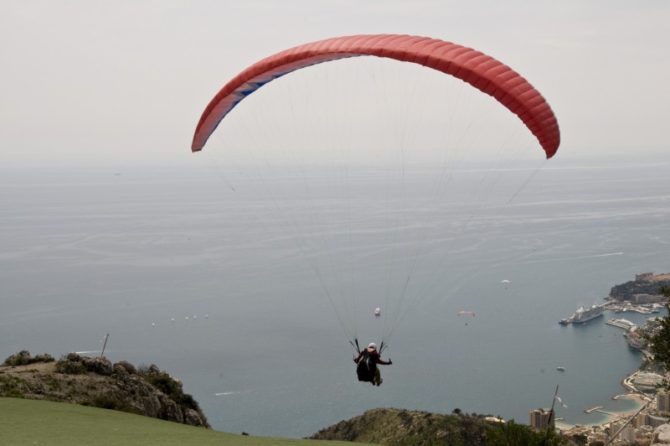Seaside Trails

The idyllic azure coast of legend is still there, not far from the packed beaches and bumper-to-bumper roads of the summertime Riviera. But it’s accessible only on foot. Planes land in the distance and speedboats cut frothy wakes on the sapphire sea, but on the region’s footpaths and hiking trails, the air is fresh and the only sounds are the chirping of birds and the raspy hum of cicadas.
MONT GROS
The two-and-a-half-hour Tour du Mont Gros offers a panorama of the coast near Monaco that literally takes your breath away. The path begins on a wide white road with views over the Mediterranean at every turn, then narrows to a switchback trail up the mountain. A few small farms spill down the hillside, and the musty, rich smell of thyme, crunched underfoot, sweetens the journey.
Near the peak of the walk is a glider launch pad, and on sunny weekends dozens of intrepid souls leap off the cliff and paraglide out over the Mediterranean coast between Menton and Monaco. There are plenty of places to sit, enchanted by these colorful human birds floating majestically over one of the world’s most spectacular coastlines. Eventually they alight on the Plage de Cabbé far below.
LE CAMP ROMAIN
The Provençal village of Le Rouret, on the road linking Grasse to Nice in the hills above the coast, is the starting point for the almost six-kilometer (four-mile) walk to and from Le Camp Romain. Flower farms and orchards that produce jasmine, violets, roses and orange blossoms for the perfume distilleries of Grasse surround you as the trail winds through the upper levels of the village past lush backyard gardens and along villa walls.
Eventually, as the pine forest offers dappled patches of shade and sun, you’ll find plenty of large flat boulders and strategically placed benches for a welcome rest. Near the top, the trail overlooks the Gorge des Trucs, a part of the Gorges du Loup. The flat crest of the hill doubles as a perfect place for a nap under a pine tree after a long picnic lunch, and you might see a dozen fellow hikers dozing here and there along your way.
A short side path leads to the site of an ancient Roman camp, excavated by archaeologist Paul Goby in the late 19th century. All of the valuable finds have been removed to museums, of course, and all that’s left to see now are the ruins of two circular walls in the overgrown brush.
Farther along there’s a sign identifying an experimental truffle farm, the Champ d’Essai Trufficole. It’s unusual—truffle farms aren’t widely advertised, so as not to entice poachers, since the “diamond of the kitchen” can sell for hundreds of dollars a pound. (Peter Mayle’s entertaining 1997 novel Anything Considered explores the subject of illegal truffle proliferation in these coastal hills.) The truffle farm is open to visitors during the annual Fête de la Truffe in January.
On your return to the village, you can stop at the boules court to watch a few games of pétanque, or do a little shopping at the local cooperative, where about twenty producers sell olive oil, cheeses, crystallized violets and many other homegrown items. For more substantial supplies, Wednesday is market day in Le Rouret.
LA BRAGUE
One of the few consistently shady places for walking the Riviera is along the river Brague between the villages of Biot and Valbonne. The Vallée de la Brague hike is some ten kilometers (six miles) one way, about a three-hour journey. Buses run regularly between the villages, but another option is to make a long day of it. Start off in one village, enjoy a leisurely lunch in the other, and then return on foot in the late afternoon. If a picnic on the riverbank appeals, you can buy the fixings at the outdoor market in Biot on Tuesday or on Friday in Valbonne. Fig trees and blackberry bushes en route also offer sustenance in the right season.
Most of the walk here is through the protected Parc de la Brague. Cascading waterfalls, stone bridges and drooping trees create a fairytale landscape right out of an Arthur Rackham illustration or a scene in The Lord of the Rings. A few deep pools make perfect swimming holes, although you might have to share them with local residents who duck in to cool off in the summer. Local authorities work hard to keep the water pure, and every three years in June, sculptors create works in situ that utilize the river environment to call attention to its importance as a natural resource.
CAP D’ANTIBES
The Tour du Cap d’Antibes is one of the few trails that skirt the seaside. Very familiar to locals but often missed by visitors, the almost five-kilometer (three-mile) path circles the tip of the Cap d’Antibes, the peninsula between Antibes and Golfe-Juan. Very popular, this is one of the few trails that might be crowded on weekends and holidays; parking in summer months may be difficult, and, very importantly, the hike is completely exposed to the sun—all the more reason to consider embarking on a quiet, early summer weekday morning or late in the day. Bring plenty of water and wear a hat—although, since this is the Riviera, you’re likely to see all manner of attire along this trail, from heavy hiking gear to high heels. But don’t let any of these warnings put you off—this may be one of the most dramatically beautiful hikes on the entire coast and the location, right in the center of the hubbub, couldn’t be better.
Good walking shoes will suffice, as the trail is a well-constructed stone path with guide rails along the steepest sections and normal stairs to climb up and down. When seas are stormy, the trail is closed about twenty minutes in from La Garoupe beach and sometimes at the other end too. The daunting Danger de Mort signs, to warn of waves that might crash up over the path and sweep hikers out to sea, are rarely seen in summer months.
Two starting points are possible for the two-hour round-trip journey, either La Garoupe beach or Château de la Croë—a 1927 Victorian-style mansion once lived in by the Duke and Duchess of Windsor, and later by Greek shipping magnate Stavros Niarchos. Either way, you’ll be passing through the middle of the tip of Cap d’Antibes, past the elegant, extravagant villas of the peninsula, to return to your car or the bus for Antibes. From La Garoupe, made famous by F. Scott Fitzgerald’s novel Tender is the Night, the trail starts on the eastern side of the beach, with views over the stone ramparts of Antibes and east toward Italy, with the pre-Alps crowning the scene.
There are plenty of stopping points where you can relax and enjoy the sea breeze or take a swim in the deep blue waters of the calanques (rocky inlets). On the Château de la Croë end, don’t miss the short side trip under the umbrella pines toward the Anse de l’Argent Faux, near Eden Roc, looking out over what’s called “Millionaire’s Bay”, in honor of the movie stars and assorted barons and oligarchs who inhabit the Cap. Time your excursion to rest your feet in the sand at one of the many cafés at La Garoupe beach and enjoy a sunset aperitif.
HIKING NOTEBOOK
A handy booklet called Pays Côtier, one of the Guides Randoxygène from the Conseil Général des Alpes-Maritimes, available at most tourist offices, describes sixty hiking itineraries. Find it online.
Itineraries range from easy to difficult, identified in the book as facile, moyen and sportif, and from an hour and a half to a full day. (The four here are facile.) Along with maps, the guides provide information about parking, change of elevation, historic sites and natural wonders, picnic facilities and more. For the adventurous, the ultimate 200-kilometer (124-mile) journey called Balcon de la Méditerranée links Marseille to Menton.
The office and website of the Fédération Française de la Randonnée Pédestre (French Hiker’s Association) in Paris offers a wealth of information. Le Centre d’Information de la Randonnée Pédestre, 64 rue du Dessous des Berges, 13th, 01.44.89.93.93. website (French only)
Another resource for maps is the Institut Géographique National (IGN), 107 rue La Boétie, 8th, 01.43.98.80.00. website (French only)
Originally published in the July/August 2009 issue of France Today; updated in June 2012
Share to: Facebook Twitter LinkedIn Email
Leave a reply
Your email address will not be published. Required fields are marked *



